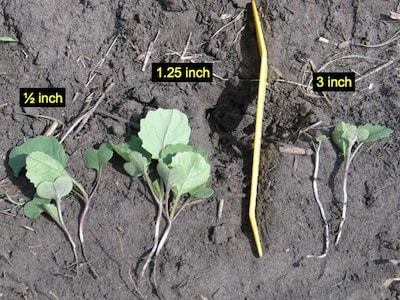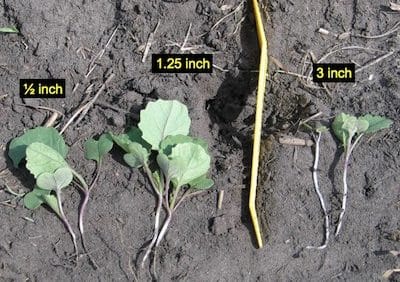
Growers are still better off seeding 1/2” to 1” deep and waiting for rain rather than trying to chase moisture in fields where the top layer of soil has dried out. The principles of good seed placement still apply. These are:
Seed shallow. Half an inch to one inch below the packer furrow is the recommended seed depth for canola. This will reduce days to emergence and reduce the seed energy required for emergence. This also reduces the number of weeds that are able to emerge ahead of the crop.
Seed at a consistent depth. The more consistent the better. For some drills, the overall average may be one inch, but the range could be 0”-2”. Too shallow or too deep both contribute to seed and seedling mortality, and those that do emerge will have highly variable emergence dates, creating an uneven field.
Seed slower to ensure good and even seed depth from all openers. The ideal speed will vary by drill and soil conditions. In general, at higher speeds, rear openers tend to throw more soil over the front rows. Seed in these front rows will be buried deeper, making them slower to emerge — if they emerge at all. Re-check depth when moving from one field to the next.
Limit seed-placed fertilizer. Seed-placed fertilizer can damage canola seedlings. There can be safe low rates of seed-placed nitrogen in some cases, but the best practice is to save the spot in the seedrow for 20-25 lb./ac. of phosphate and put other nutrients away from the seed row.
Penetrate trash. Spread residue evenly in the fall, and have a drill that can penetrate trash so all openers place seed into the soil.
Leave a firm seedbed. Openers that fracture the seedbed to place fertilizer lower than the seed may not provide the firm moist seedbed that canola needs. Worn openers that do not provide a defined seed ledge and high fan speeds that cause seed bounce can also reduce an opener’s ability to place seed precisely.
Pack appropriately. In dry conditions, pack more to conserve moisture in the seed row. In wet conditions, reduce packing pressure to limit hard crusting. Packing pressure can be a delicate balance, and often changes by soil type as well as moisture conditions.

